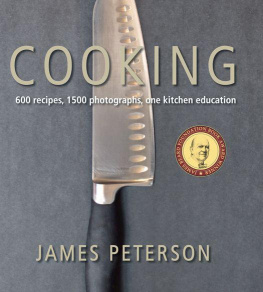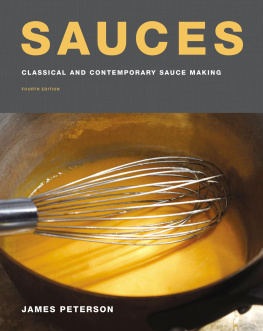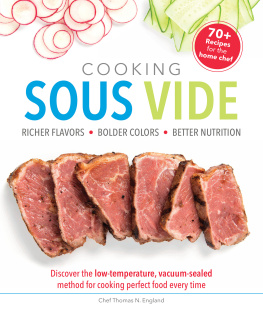

Copyright 2014 by James Peterson.
All rights reserved. No part of this book may be reproduced in any form without written permission from the publisher.
ISBN 978-1-4521-3228-0 (epub, mobi)
Library of Congress Cataloging-in-Publication Data:
Peterson, James.
Done : a cooks guide to knowing when food is perfectly cooked / James Peterson.
pages cm
Includes index.
ISBN 978-1-4521-1963-2 (alkaline paper)
1. Cooking. I. Title.
TX652.P46 2014
641.3dc23
2013026809
Designed by William van Roden
Cover design by Vanessa Dina and William van Roden
Chronicle Books LLC
680 Second Street
San Francisco, California 94107
www.chroniclebooks.com
Acknowledgments
While seemingly a simple book about a simple subject, the production of a book like this takes a mammoth amount of energy from a surprising number of people.
My first thanks are to Lorena Jones, my editor, for her enthusiasm, conscientiousness, and eye for detail. She has taken care of me throughout the yearlong process of writing the initial manuscript. Her criticisms are thoughtful but never barbed.
And while I hate to admit her job is as difficult as it is, I must thank copy editor Jane Tunks for her incredible thoroughness. Working with her has been a real pleasure and has taught me how to be a better writer.
The books sprightly design came as a complete surprise, as I never would have envisioned something so dynamic and full of color. Thanks must go to Vanessa Dina and William van Roden.
Shooting the pictures was the hardest part of producing this book. I must thank Nate Meshberg for his unstinting effort, assistance, and creative input in producing the photography. Working with him was such a pleasure.
And then there are those in my personal life who keep me going and on the straight and narrow. My agents Elise and Arnold Goodman are always there for me and guide me through projects large and small. My appreciation is limitless. I also thank Joel Hoffman for his guidance and professionalism. And I must never forget my friends, without whom little would seem possible.
Last and of course not least, I must thank my husband, Zelik Mintz, for simply being there.
DONE. CONTENTS
Introduction
When people asked me what I was working on as I was writing this book and I told them a book about doneness, there was a moments hesitation, as though they didnt hear me quite right. It was only when I explained how determining doneness is the Achilles heel of many a would-be confident cook that their faces brightened up with understanding.
Cooking is the application of heat to various foods using a limited number of methods and for varying periods of time. Most cooking techniques are straightforward. You put something in the oven to roast it, or in a frying pan to saut it, or you put it on the grill. The trick is to know when to stop cooking.
Many of us dont even recognize properly cooked foods, much less how to prepare them. A well-roasted chicken is still pink inside the thigh, and a grilled scallop should be translucent. Pork or veal chops should be cooked medium, not to order as suggested in many a restaurant. Every food has its optimum degree of cooking.
Of all the mistakes we are likely to encounter in restaurants or make ourselves at home, most involve doneness, typically overcooking. Every fish book in my library says to cook a lobster for 20 minutes; I suggest cooking it just 4 minutes. Suggestions for roast chicken and turkey say that the internal temperature should be 160F/71C or even more, guaranteeing that it will be overcooked. I say 140F/60C for a chicken or turkey. Seafood is often subjected to the horrors of too much heat for too long. Keep in mind that most seafood is best raw, but once you decide to cook it, it should not be undercooked. The flesh of a properly cooked whole fish should barely cling to the bones and be slightly pink and translucent where it attaches. Fish should not be flaky.
Once you recognize what doneness looks like (or, more likely, feels like)and there are plenty of pictures here to help you with thatyou need to think about the cooking process itself and match the correct cooking method to the food being prepared. Techniques for determining the doneness of a braise are completely different than those used for a roast; a loaf of bread requires different criteria than does a cake. You need to know the best method for getting therehigh heat for roasting, low heat for braising, medium heat for baking. Some foods must be seized on the stove, which is to say they should sizzle when you place them in the fat. Here, Ive included a number of tricks, such as taking the thighbone out of a chicken so it cooks at the same rate as a breast or grilling a fish with its scales on so it doesnt stick to the grates.
As you become a more experienced cook, determining donenessthe most difficult aspect of cookingwill become second nature and very much intuitive. One of the most difficult foods to cook properly is a large roast because it changes relatively little during the early stages of cooking. Youll learn to look at the juices it releases (as well as their color), the feel the roast should have when you press on it, and, of course, the appropriate internal temperature.
Here, cooking times have been downplayed and, in fact, are often not included at all. Since ovens are notoriously inaccurate and everyone has a different touch, its best to work out your own cooking times from experience. It may help, for example, to determine that a turkey takes about 10 minutes per 1 lb/455 g to cook in a 350F/175C oven, but these are only estimates so you can organize your cooking schedule, not surefire guides to appropriate doneness.
Much of cooking is intuitive or, if not actually intuitive, based on a huge amount of sensory input. A chicken jus develops a particular smell when it reaches the exact point that its done; a rack of lamb will stiffen in a characteristic and easy-to-measure way. Every food has its little tricks and, sometimes, subtle changes that act as clues for measuring doneness. Once these are mastered, cooking indeed becomes a joy.
HOW WE DETERMINE DONENESS
COOKING MAY BE THE ONLY ART FORM that requires all the senses. The sound of meat sizzling alerts you that the flame is hot enough; the smell of juices caramelizing tells you a roast is ready; and the texture of meat and seafood tells you, by feel, when theyre done.
While determining doneness does indeed require all five senses, it is touch that is perhaps the most important. This is because we determine the doneness of many cuts of meat and fish by pressing on them and assessing their texture. Meats, and proteins in general, become firm to the touch as they cook. To get a feel for this, press on a muscle on your body that isnt flexed (the muscle on the inside of the base of the thumb is a good one; the bicep, another) and just flex the muscle. Another way to familiarize yourself with this technique for determining doneness is to cook a boneless chicken breast in a saut pan or over a grill and then touch it as it cooks. Because chicken breasts are usually thinner at one end, you can feel the firmness start there and then work its way up to the thicker part of the breast. As soon as the entire breast springs back to the touch, it is done. Further cooking will only dry it out.
Things become a little trickier when we cook red meat because we have to cook it to varying degrees, depending on peoples taste. A rare steak will feel completely fleshy, a medium-rare steak will just begin to feel slightly firm, and a medium steak is ready as soon as it feels firm like a flexed muscle. White meatveal, pork, or chickenis always cooked to the same degree, which is to say medium.
Next page








